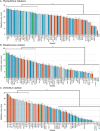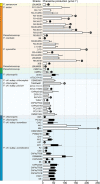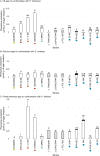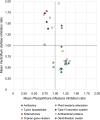Inhibition of Three Potato Pathogens by Phenazine-Producing Pseudomonas spp. Is Associated with Multiple Biocontrol-Related Traits
- PMID: 34077259
- PMCID: PMC8265658
- DOI: 10.1128/mSphere.00427-21
Inhibition of Three Potato Pathogens by Phenazine-Producing Pseudomonas spp. Is Associated with Multiple Biocontrol-Related Traits
Abstract
Phenazine-producing Pseudomonas spp. are effective biocontrol agents that aggressively colonize the rhizosphere and suppress numerous plant diseases. In this study, we compared the ability of 63 plant-beneficial phenazine-producing Pseudomonas strains representative of the worldwide diversity to inhibit the growth of three major potato pathogens: the oomycete Phytophthora infestans, the Gram-positive bacterium Streptomyces scabies, and the ascomycete Verticillium dahliae. The 63 Pseudomonas strains are distributed among four different subgroups within the P. fluorescens species complex and produce different phenazine compounds, namely, phenazine-1-carboxylic acid (PCA), phenazine-1-carboxamide (PCN), 2-hydroxyphenazine-1-carboxylic acid, and 2-hydroxphenazine. Overall, the 63 strains exhibited contrasted levels of pathogen inhibition. Strains from the P. chlororaphis subgroup inhibited the growth of P. infestans more effectively than strains from the P. fluorescens subgroup. Higher inhibition was not associated with differential levels of phenazine production nor with specific phenazine compounds. The presence of additional biocontrol-related traits found in P. chlororaphis was instead associated with higher P. infestans inhibition. Inhibition of S. scabies by the 63 strains was more variable, with no clear taxonomic segregation pattern. Inhibition values did not correlate with phenazine production nor with specific phenazine compounds. No additional synergistic biocontrol-related traits were found. Against V. dahliae, PCN producers from the P. chlororaphis subgroup and PCA producers from the P. fluorescens subgroup exhibited greater inhibition. Additional biocontrol-related traits potentially involved in V. dahliae inhibition were identified. This study represents a first step toward harnessing the vast genomic diversity of phenazine-producing Pseudomonas spp. to achieve better biological control of potato pathogens. IMPORTANCE Plant-beneficial phenazine-producing Pseudomonas spp. are effective biocontrol agents, thanks to the broad-spectrum antibiotic activity of the phenazine antibiotics they produce. These bacteria have received considerable attention over the last 20 years, but most studies have focused only on the ability of a few genotypes to inhibit the growth of a limited number of plant pathogens. In this study, we investigated the ability of 63 phenazine-producing strains, isolated from a wide diversity of host plants on four continents, to inhibit the growth of three major potato pathogens: Phytophthora infestans, Streptomyces scabies, and Verticillium dahliae. We found that the 63 strains differentially inhibited the three potato pathogens. These differences are in part associated with the nature and the quantity of the phenazine compounds being produced but also with the presence of additional biocontrol-related traits. These results will facilitate the selection of versatile biocontrol agents against pathogens.
Keywords: Phytophthora infestans; Pseudomonas; Solanum tuberosum; Streptomyces scabies; Verticillium dahliae; biocontrol; phenazine.
Figures







Similar articles
-
Metabolic and Genomic Traits of Phytobeneficial Phenazine-Producing Pseudomonas spp. Are Linked to Rhizosphere Colonization in Arabidopsis thaliana and Solanum tuberosum.Appl Environ Microbiol. 2020 Feb 3;86(4):e02443-19. doi: 10.1128/AEM.02443-19. Print 2020 Feb 3. Appl Environ Microbiol. 2020. PMID: 31811040 Free PMC article.
-
Pan-genome analysis identifies intersecting roles for Pseudomonas specialized metabolites in potato pathogen inhibition.Elife. 2021 Dec 31;10:e71900. doi: 10.7554/eLife.71900. Elife. 2021. PMID: 34792466 Free PMC article.
-
Phenazine-1-Carboxylic Acid Production by Pseudomonas fluorescens LBUM636 Alters Phytophthora infestans Growth and Late Blight Development.Phytopathology. 2017 Mar;107(3):273-279. doi: 10.1094/PHYTO-06-16-0247-R. Epub 2016 Dec 30. Phytopathology. 2017. PMID: 27827009
-
Phenazines in plant-beneficial Pseudomonas spp.: biosynthesis, regulation, function and genomics.Environ Microbiol. 2018 Nov;20(11):3905-3917. doi: 10.1111/1462-2920.14395. Epub 2018 Oct 15. Environ Microbiol. 2018. PMID: 30159978 Review.
-
Pseudomonas chlororaphis metabolites as biocontrol promoters of plant health and improved crop yield.World J Microbiol Biotechnol. 2021 May 12;37(6):99. doi: 10.1007/s11274-021-03063-w. World J Microbiol Biotechnol. 2021. PMID: 33978868 Review.
Cited by
-
In Tuber Biocontrol of Potato Late Blight by a Collection of Phenazine-1-Carboxylic Acid-Producing Pseudomonas spp.Microorganisms. 2021 Dec 7;9(12):2525. doi: 10.3390/microorganisms9122525. Microorganisms. 2021. PMID: 34946127 Free PMC article.
-
A novel high-throughput screen identifies phenazine-1-carboxylic acid as an inhibitor of African swine fever virus replication in primary porcine alveolar macrophages.Vet Res. 2025 Feb 8;56(1):37. doi: 10.1186/s13567-025-01467-2. Vet Res. 2025. PMID: 39923101 Free PMC article.
-
Biocontrol and Growth Promotion of Rice by Pseudomonas aeruginosa SNTKU16: Beneficial Properties and Genomic Potential.J Microbiol Biotechnol. 2025 Feb 14;35:e2411067. doi: 10.4014/jmb.2411.11067. J Microbiol Biotechnol. 2025. PMID: 39947704 Free PMC article.
-
Optimized CRISPR Interference System for Investigating Pseudomonas alloputida Genes Involved in Rhizosphere Microbiome Assembly.ACS Synth Biol. 2024 Sep 20;13(9):2912-2925. doi: 10.1021/acssynbio.4c00312. Epub 2024 Aug 20. ACS Synth Biol. 2024. PMID: 39163848 Free PMC article.
-
2,4-Diacetylphloroglucinol producing Pseudomonas fluorescens JM-1 for management of ear rot disease caused by Fusarium moniliforme in Zea mays L.3 Biotech. 2022 Jun;12(6):138. doi: 10.1007/s13205-022-03201-7. Epub 2022 May 24. 3 Biotech. 2022. PMID: 35646503 Free PMC article.
References
-
- Burlingame B, Mouille B, Charrondiere R. 2009. Nutrients, bioactive non-nutrients, and anti-nutrients in potatoes. J Food Compos Anal 22:494–502. doi:10.1016/j.jfca.2009.09.001. - DOI
-
- Devaux A, Kromann P, Ortiz O. 2014. Potatoes for sustainable global food security. Potato Res 57:185–199. doi:10.1007/s11540-014-9265-1. - DOI
-
- Oerke EC. 2006. Crop losses to pests. J Agric Sci 144:31–43. doi:10.1017/S0021859605005708. - DOI
-
- Guenthner JF, Wiese MV, Pavlista AD, Sieczka JB, Wyman J. 1999. Assessment of pesticide use in the United States potato industry. Am J Pot Res 76:25–29. doi:10.1007/BF02853554. - DOI
-
- Haverkort AJ, Boonekamp PM, Hutten R, Jacobsen E, Lotz LAP, Kessel GJT, Visser RGF, van der Vossen EAG. 2008. Societal costs of late blight in potato and prospects of durable resistance through cisgenic modification. Potato Res 51:47–57. doi:10.1007/s11540-008-9089-y. - DOI
Publication types
MeSH terms
Substances
Supplementary concepts
LinkOut - more resources
Full Text Sources
Miscellaneous

